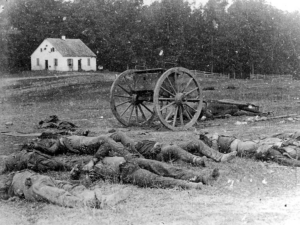
The book I’m currently writing, Documenting America: Civil War Edition, is currently sitting on a chair in our kitchen, waiting for me to get back to it. I finished it about ten days ago, and I’m letting it sit a while, giving me space and perspective, before I start the editing process. I anticipate the editing will take two or three weeks. Then publishing tasks can begin.
Meanwhile, the Civil War is back in the news. Several Civil War monuments are being removed in the City of New Orleans. These are monuments to Confederate leaders, such as Robert E. Lee, Confederate General. This follows several other places where similar monuments have been removed.
I have mixed feelings about this. Since the reason the states that formed the CSA withdrew (i.e. seceded) from the USA was because they wanted to preserve slavery, those monuments are in essence to those who wanted to preserve slavery. Those descended from slaves naturally are appalled that, in the 21st Century, we are still honoring those who enslaved their ancestors. Those who weren’t descended from slaves, but who align with those who brought pressure for abolition, are also appalled. I think I understand their concerns.
On the other hand, some say those monuments don’t mean the same today as they did when they were first erected. Now, they are simply recognition of those who loved their country, even if their views of what that country did were misguided. They say: Would you also removed monuments to George Washington and Thomas Jefferson, both slave owners from the south? They have a good point. Washington and Jefferson didn’t take part in rebellion. Oh, wait, they did: rebellion against England. But, that was a good rebellion, working for a government that would protect the natural rights of man, a.k.a. God-given rights. So that’s different.

I have a different view of it. Those monuments have become history books in their own right. By destroying the monuments, we are destroying history books, and trying to expunge history. Is this a good thing?
At one time I thought, “History is history. It is what it is: just a bunch of facts, and dates, and actions by people that happened, and are passed down to those who didn’t experience them.” Then I started writing about history. And I read much by others, both history books and how-to-write-history books. And I learned that how a historical event is treated in a book depends on how the writer does his research and puts the book together. Facts are facts, but you can ignore some and over emphasize others. You can twist some into your opinion mold and make them say something different than what another writer will say about the same fact.
So history isn’t really history. All history is interpretation of what happened in the past. Sometimes it comes with an agenda. Sometimes it comes with a preconceived notion that the historian has been able to make sure you see in the work, causing you to think “Oh, sure, it’s obvious that’s how it was.” However, if you read a book by Historian A instead of Historian B, you would get a completely different picture. I wish it wasn’t so. I wish history was history. But, alas, it’s not.
Back to the Confederate monuments. They represent a dark time in our history, a time when a few white people thought they had the right to enslave a bunch of black people, and to go fetch more black people through an illegal trade. The monuments were meant to honor that dark time. Now we know better. Why not use that to our advantage, keep the distasteful monuments, and use them for a different purpose?
Imagine this, with the monuments still standing. You’re in New Orleans, with your young children or grandchildren. You come across the monument of Robert E. Lee. Your child asks, “Who’s that man up on that horse?” What a great teaching moment that is. “He’s a man who thought it was okay to enslave people simply because they were of a different race. He might have been a good man at heart, but his actions were to perpetuate a way of life that had one race the masters and one race the slaves. This monument was once put up to honor him, but now we know it’s here to help us to never forget just how evil that practice was.”
Now THAT would be a great moment. That would be a great monument. Turn its purpose on its head and make it mean the exact opposite of what it was intended for 140 years ago, or whenever it was erected. How much better that would be than removing it.
The old cliché goes, those who don’t learn history are doomed to repeat it. Well, those who expunge history won’t learn from it. As a result, we may not learn the evils of slavery as we should. Slavery won’t return, I don’t think, but what other evil practice may happen as a result of us not having that history before us, right in our face, forcing us to confront that dark past?
It’s something to think about.
I’m pretty much in agreement with you, David. Also not mentioned here is the fact that some of those commemorated by these monuments were honorable people. Robert E. Lee comes to mind. He didn’t really want to secede from the union but fought for his country, which he identified as Virginia.
There was a different mindset back in those times, and it’s something that we 21st century people will never fully understand. Slavery was wrong, of that I have no doubt. But what about globalization and the fact that much of our clothing is made by poverty-stricken people in third-world countries in unsafe working conditions; these, making barely enough money to subsist on. It’s really not all that different.
In any event, I agree with you.
Two other cases of using the ugly side of historical monuments come to mind. The complete name of our home state is “The State of Rhode Island and Providence Plantations” as you know. Every few years a bill is submitted to the legislature to drop the Plantations part because the word recalls the slave-holding Southern plantations. RI plantations were fewer in number but they did in fact hold some slaves up to the mid-1800s. And slave trading was a major industry run by prominent RI families in the 1700s. There is some but limited public sentiment to change the State name for these reasons and the bills fail to pass. Reasonable people understand the hurt some feel, yet to revise the name would further hide a very dark stain that needs exposure to the light. We can’t learn from what we don’t know.
Another similar situation is with the Baseball Hall of Fame that so far has refused to induct players who used performance-enhancing drugs. Some sports writers want to induct the guilty players — probably, I assume, downplaying the use of PEDs. A solution might be to induct them to the HOF, but have a separate location referencing what many consider to be cheating — a so-called Wall of Shame. You could throw in other certified miscreants (Ty Cobb and the 1918 White Sox come to mind) as well. These episodes and monument can provide what are called “teaching moments.”
A.D. and Gary:
Thanks for reading my post, and for the comments. You both make good points.